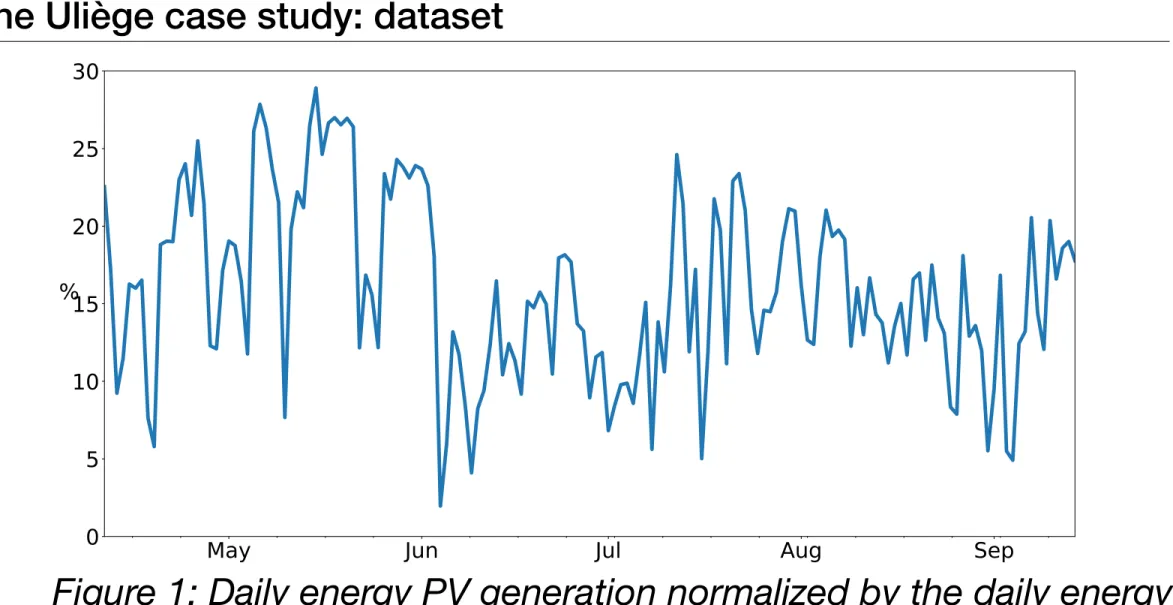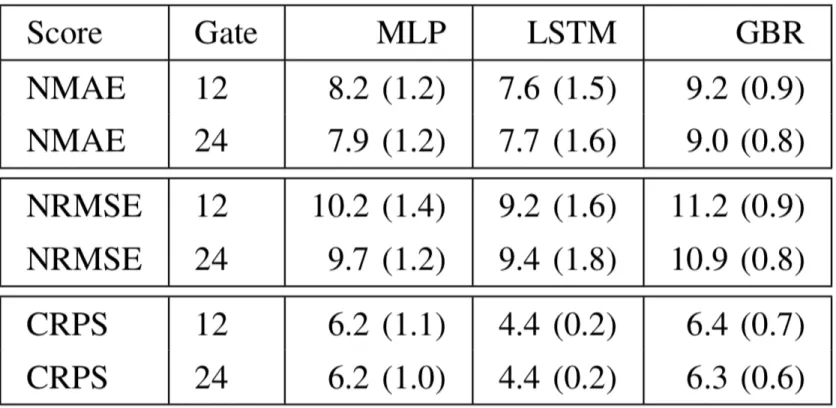Deep learning-based multi-output quantile
forecasting of PV generation
Jonathan Dumas°, Colin Cointe°*, Xavier Fettweis*, Bertrand Cornélusse°
° Computer science and electrical engineering department, Local energy community laboratory. °* Ecole Nationale Supérieure des Mines de Paris, Master internship.
* Geography department, Climatology laboratory Belgium.
Probabilistic forecasting context System
-> PV/wind plant -> uncertainty on the generation
Goal
-> The intermittent power from a PV/wind plant has to be predicted to improve decision-making (such as robust-optimization) on a day ahead and intraday basis
How ?
-> in contrast to point predictions, probabilistic forecasts aim at providing decision-makers with the full information about potential future outcomes
Forecasting timeline
IA meeting
Time resolution is 15 minutes -> 96 time steps per day Day ahead forecasts:
-
1 time gate 12:00, day D;-
prediction for D+1 from 00:00 to 23:45 (96 forecasting time periods) Intraday forecasts:-
4 time gates 00:00, 06:00, 12:00, and 18:00, day D+1-
prediction for D+1 from 00:00/06:00/12:00/18:00 to 23:45 (96/72/48/24forecasting time periods).
Quantiles:
Contributions
A tailored deep learning-based multi-output quantile PV forecaster:
-
a deep learning-based multi-output quantile architecture;-
implement & test an encoder-decoder architecture;-
use the weather forecasts of the MAR regional climate model;-
a proper assessment of the quantile forecasts is conducted by using a k-cross validation methodology and probabilistic metricsps: this is not rocket science … we are not machine learning experts so any
feedback to help us to improve the approach is welcome :)
Summary
1. Literature review -> cf paper
2. Quantile regression -> cf paper
3. Forecasting techniques
4. Probabilistic forecasting quality assessment
5. Case study
6. Conclusions & perspectives
IA meeting
Forecasting techniques
Day ahead models:
-
GBR (scikit-learn);-
MLP (PyTorch) with one hidden layer -> used also for intraday forecasts;-
LSTM cell & a feed-forward layer, named LSTM (TensorFlow) -> used also forintraday forecasts;
Intraday models (encoder-decoder):
-
LSTM-MLP named ED-1 (TensorFlow);-
LSTM-LSTM named ED-2 (TensorFlow).Forecasting model inputs
Day ahead models (GBR/MLP/LSTM) inputs:
-
air temperature 2 m;-
solar irradiation.Intraday models (MLP/LSTM/ED-1/ED-2) inputs:
-
air temperature 2 m;-
solar irradiation;-
last 3 hours of PV generation (not for LSTM).Weather forecasts are provided by the MAR regional climate model
from the Climate laboratory of Liège University: link.
Summary
1. Literature review
2. Quantile regression
3. Forecasting techniques
4. Probabilistic forecasting quality assessment
5. Case study
6. Conclusions & perspectives
IA meeting
Probabilistic forecasting quality assessment Value vs quality:
-
quality: ability of the forecasts to genuinely inform of future events bymimicking the characteristics of the processes involved;
-
value: benefits from using forecasts in a decision-making process such asparticipation to the electricity market.
Focus on the forecast quality assessment:
-
Continuous Rank Probability Score (CRPS) -> cf paper for def-
Winkler Score (WS) -> cf paper for defSummary
1. Literature review
2. Quantile regression
3. Forecasting techniques
4. Probabilistic forecasting quality assessment
5. Case study
6. Conclusions & perspectives
IA meeting
The Uliège case study: dataset
Figure 1: Daily energy PV generation normalized by the daily energy produced by the total installed capacity.
Validation strategy
11-cross validation:
-
142/15 days per pair;- scores (NMAE, NRMSE, CRPS, WS) are averaged over the 11 pairs. Forecasting time periods k:
-
11 <= k <= 80: PV generation always 0 for 0 <= k <= 10 & 81 <= k <= 95Day ahead results: point and quantile forecasts
IA meeting
Figure 2: Quantiles vs point forecasts of day ahead models on August 2, 2020. (b) LSTM
Day ahead results: point and quantile forecasts
Day ahead results: point and quantile forecasts
IA meeting
Table 1: Averaged NMAE, NRMSE, and CRPS of the day ahead models (%).
Intraday results: point and quantile forecasts
IA meeting
(b) ED-2 (LSTM-LSTM)
Intraday results: quantile forecasts
Intraday results: quantile forecasts
IA meeting
Conclusions & perspectives
IA meeting
Results:
- best day ahead model for both point & quantile forecasts: LSTM;
- LSTM-MLP yields accurate results in comparison with the MLP & LSTM-LSTM models.;
- LSTM produced similar results than the LSTM-MLP. Perspectives:



